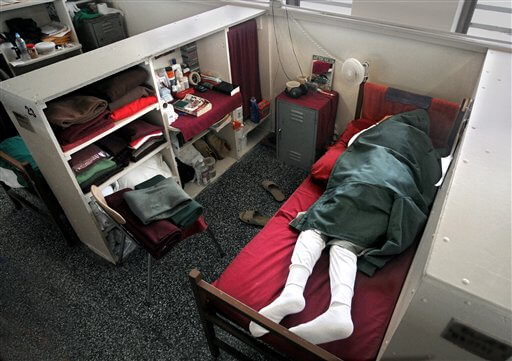
Nearly 40 years after tough new drug laws led to an explosion in prison rolls, New York state has dramatically reversed course, chalking up a 62 percent drop in people serving time for drug crimes today compared with 2000, according to a Poughkeepsie Journal analysis.
The steep decline — driven, experts said, by shifting attitudes toward drug offenders and lower crime — means that nearly 17,000 fewer minorities serve state time today than in 2000, groups that were hardest hit by the so-called war on drugs. Overall, the prison population declined 22 percent.
Hispanics and blacks are still vastly overrepresented in prisons but incarceration experts said the overall figures were impressive.
“The drop itself is really quite extraordinary,” said Michael Jacobson, director of the Manhattan-based Vera Institute of Justice, a nonprofit center for justice policy research.
“This is very intriguing stuff and encouraging,” said Marc Mauer, executive director of the Sentencing Project, a Washington, D.C.-based organization that has criticized sentencing policies as racially biased and counterproductive.
Nationally, New York charted the biggest drop in its prison rolls from 2000 to 2010, a decade when 37 state prison systems had double-digit population hikes. Ironically, it was the state’s 1973 drug laws, championed by then-Gov. Nelson A. Rockefeller, that helped kick off a massive national prison buildup — and the highest incarceration rate in the industrialized world.
Now — with state prison spending at $3.7 billion in fiscal 2010, or $55,000 per inmate — New York may be leading the way back.
Nearly 7,700 fewer blacks are incarcerated in state prison in 2011 compared with 2000, the Journal study found. In addition, 35 percent fewer female inmates serve time — and 77 percent fewer women serve drug sentences as their top crime. Inmates were also older — by three years on average, according to the analysis, which used databases of the inmate population on one day each in February 2000 and March 2011.
The trend is an outgrowth, experts said, of factors including the diversion of more drug offenders to treatment, changes in drug laws and lower crime rates — especially in New York City, which currently ranks among the safest big cities in America. There, aggressive “stop-and-frisk,” zero-tolerance and computer-driven anti-crime programs have been employed, some say, with remarkable results.
“It’s exactly these policies,” said the Vera Institute’s Jacobson, “that are driving crime down.”
While the New York City policies are highly controversial — 600,000 people were frisked in 2010, statistics show, 90 percent of them minorities — there’s little doubt of the city’s mighty contribution to the state’s prison reversal. The five boroughs charted a 42 percent decline in sentenced inmates in 2011 compared to 2000; inmates from the rest of the state actually increased 17 percent. Both the city and upstate saw big declines in drug commitments — but the city’s decline, 76 percent, was three times that of upstate.
The decline in drug-convicted inmates means more of the type of inmate for which penitentiaries were constructed: violent offenders.
Today, the No. 1 top crime of sentenced inmates is second-degree murder, with just over 8,000 convicts — about the same as in 2000.
In 2000, the most common top crime for which inmates were incarcerated was third-degree criminal sale of a controlled substance – with almost 10,000 people sentenced. That’s now down to about 3,000.
“I would argue that the right people are being sentenced to prison,” said Brian Fischer, New York state’s prison commissioner. “Was prison the best alternative for drug abusers? Clearly it was not.”
While Fischer also favors diverting nonviolent mentally ill offenders to achieve further downsizing — “that’s the goal,” he said- – he doesn’t plan to close any more than the nine prisons already closed and one more in process. In fact, while the system lost 15,800 inmates since 2000, it has closed just 6,277 beds — a hard-fought battle in a state in which prisons sustain many job-poor upstate communities.
Before adoption of its drug laws in 1973, New York had built just 18 prisons in 140 years. Driven by mandatory drug sentences and other tough-on-crime statutes, the state opened 52 prisons from 1973 to 2000, raising the population from 13,400 to a historic peak, on Dec. 12, 1999, of 71,538 inmates. It was 55,599 last week.
With the population shrinking, the state closed three of its 69 prisons in 2009 and six more as of Oct. 1, with Arthur Kill prison on Staten Island set to close by Dec. 1. Portions of eight other prisons have also been closed since 2009.
The downsizing is embraced by Fischer, reform advocates and the District Attorneys Association of the State of New York, which had long resisted drug-law changes that would cede some prosecutorial power to judges.
“It wasn’t in anyone’s interest to wholesale incarcerate anyone who committed a drug crime,” said the group’s president, Janet DiFiore, a former judge and current Westchester County district attorney. “For those hundreds and hundreds and hundreds of people who were just unfortunately drug-addled people, that wasn’t the right view.”
DiFiore ties the prison downturn both to drug law reforms — in 2004, 2005 and 2009 — and a recognition in law enforcement that alternatives like drug treatment were needed. Almost 200 drug courts have been opened statewide, most since 2000, that divert many otherwise prison-bound offenders to treatment.
The downsizing doesn’t impress some reform advocates, who still see the system as hugely bloated, especially with blacks and Hispanics, now 77 percent of inmates and down from 84 percent in 2000.
“The disparities have diminished somewhat and that’s good news, but that does not put us as a state in a place that we can be proud of,” said Donna Lieberman, executive director of the New York Civil Liberties Union, which has opposed city frisking policies as invasive and discriminatory. “We were starting at a pretty horrific place from which to decline.”
“The prosecution of drug offenses is still tremendously racially biased,” said Jack Beck, a project director for the Correctional Association of New York, which monitors state prisons
What’s clear is that the downturn is continuing — equal to one or two large prisons in each of the last three years. And it may accelerate with most experts agreeing that the latest drug law reforms have yet to fully kick in.
In 2009, amendments to the Drug Law Reform Act gave judges far broader discretion to divert offenders to drug treatment or sentence them to lesser, non-mandatory, terms. In 2004 and 2005, the act reduced the harshest sentences — 15 years to life for selling as little as two ounces of cocaine or possessing four ounces — but those reforms only marginally reduced the population, experts said.
The reforms are an outgrowth of something much larger than a drug-war backlash, according to close prison observers, among these ballooning prison budgets, the economic downturn and a realization that punishment isn’t always the answer.
“Prosecutors were recognizing that our job was not just about handcuffs and prison,” said DiFiore. “It was a mindset change.”
“In a time of economic recession it causes a rethinking,” said Alan Rosenthal, director of justice strategies for the Center for Community Alternatives, a Manhattan-based sentencing reform group. “We had a shift from tough on crime to smart on crime,” an acknowledgement, he added, that high prison rolls did not equate with lower crime.
Rates of major crime in New York state have dropped 63 percent since 1990 — a consistent decline even as the prison population rose an average 4 percent a year in the 1990s and declined an average 2 percent a year in the 2000s.
The latest prison closures will save taxpayers $72 million in fiscal 2011, according to state officials – about 2 percent of the prison budget, which grew 30 percent since 2000. Fischer, the prison commissioner, attributed the growth to new mental health and disciplinary programs required under law and in settlement of a lawsuit against the system, expanded sex offender treatment and increasing personnel costs.
When he announced the latest closure plans last June, Gov. Andrew Cuomo called the system “too inefficient and too costly with far more capacity than what is needed.” But he also recognized that prisons were “a major source of employment and economic sustainability,” and set up a $50 million economic development fund to help affected communities.
Two-thirds of the state’s prisons saw double-digit percentage declines in population since 2000, the Journal analysis found, and Fischer, the prison commissioner, would like to see other inmates diverted.
“If alternatives work rather well for nonviolent drug offenders,” he said, “we should talk about alternatives that we don’t have now for people with mental illness or medical problems,” especially as the population ages.
Copyright 2011 The Associated Press.



























